Chapter 10—
Epilogue "Sopra Le Stanze Del Petrarca in Laude Della Madonna"—
Rore's Vergine Cycle of 1548
In proposing ways to read large lyric forms from start to finish Venetian madrigalists took on one of the principal challenges to cinquecento polyphony. The new mood of lingering meditation that pervaded their madrigals in the 1540s was chiefly sustained by adapting the imitative strategies of sacred polyphony to the long lines and formal units of whole sonnets. But imitative polyphony, especially as embodied in sacred form, made a strange match for lyric verse. Lurking in those vast, cerebral settings was something that contradicted the deepest lyric principles of concision, melodiousness, and spontaneity.
To be sure, a composer like Rore could turn these expansive proportions to rich expressive account, even while working within the general confines of a Ciceronian poetics that placed decorum at its aesthetic core. From this centrist position, Rore's expressivity continually pressed against boundaries that guarded the way to more eccentric idioms. By the time of his Quattro libro a 5 and Secondo libro a 4, both published in 1557, the rhetorical lessons of Venetian madrigals had been absorbed into tighter, more emotional settings — shorter in the main, more direct, and more extreme. Rore's ponderous early madrigals contrast sharply with the pithy style he sought in these later ones; but the extravagance of his late style nonetheless grew out of gestures he was cultivating from the start. In this last chapter I locate Rore's stylistic shift within his Vergine cycle, his setting of Petrarch's final canzone (no. 366), first printed in 1548-49.
Rore's Vergine sits at a crossroads between his early and late manners, representing the consummation of the old and beginning of the new. On the one hand, the cycle was his last major contribution to the repertory of Venetian-styled madrigals and to the ideals of Venetian Petrarchism, epitomizing propensities toward elegiac breadth and introspection that were the fountainhead of his Italian style. Its polyphony remains largely imitative and continuous, and its harmony coolly
diatonic. At the same time, its wealth of animated declamation, flexible speech rhythms, sharply pitted homorhythmic duets and trios, overt madrigalisms, and sudden shifts of pace and texture betoken deep shifts beneath the surface that make it a pivotal work not only in Rore's development but in the whole development of lyric part singing in Italy. With these techniques Rore rearranged the basic textual components of vocal polyphonic architecture that had ensured Venetian madrigals their measured flow. His Vergine questions Venetian norms through a new form of poetic reading — a reading that enlarges the relatively minor rift between Rore's earliest efforts and the Musica nova into a major aesthetic gulf.
Let me begin by expanding slightly some bibliographical details of the Vergine 's publication that I first broached in Chapter 3.[1] Rore set the Vergine canzone as a cycle of eleven madrigals, one on each of the poem's stanzas. Around April 1548, when Rore had already been chapelmaster at Ferrara for at least two years, the first editions of his Terzo libro a 5 by Scotto and Gardane printed stanzas one through six. In this fragmentary state the cycle was decidedly incomplete and quite likely had been issued without Rore's approval. Furthermore, neither the dedication of the Scotto edition to Gottardo Occagna nor of the Gardane edition to the poet-cleric Giovanni della Casa was made by Rore himself, and neither dedication claimed to have Rore's blessing. Not long after the initial editions appeared, and probably in 1549 as Mary Lewis has argued, both printing houses issued supplements to their respective editions appending the last five stanzas along with three additional madrigals.[2] This made the cycle complete, but Rore must still have wanted it revised: in 1552 the whole was reissued by Gardane in a complete edition containing substantial alterations to the original printed versions.[3] Gardane's revised edition can be taken as the final bibliographical bit of a compositional puzzle whose first pieces were set in place by mid-1547, by which time at least the first six stanzas must have existed in draft.[4]
I will bring my account of midcentury Venetian madrigals to a close by suggesting that musical aspects of the work's two sections — stanzas 1 to 6 and 7 to 11 — reveal a work stratified in its compositional genesis as well as its dissemination. Each section seems to represent not merely different stages at which printers acquired portions of the cycle but different compositional layers, hence stages, in Rore's approach to setting text. Taken in sum, discrepancies between the two layers offer a remarkable lens through which to view Rore's refocusing of the Venetian
[1] For more details see Chap. 3 nn. 31-35.
[2] These supplements appear in fewer than a handful of copies of the Terzo libro; for a listing see Mary S. Lewis, "Rore's Setting of Petrarch's Vergine bella: A History of Its Composition and Early Transmission," Journal of Musicology 4 (1985-86): 366-67, Tables 1 and 2. It was only the altus part book of Gardane's supplement that actually carried the dedication to della Casa.
[3] This is the version reflected in the edition of Bernhard Meier and the one from which I will cite. No substantive revisions from the earlier editions appear in the examples shown in this chapter. For the complete cycle see Cipriani Rore, Opera Omnia, ed. Bernhard Meier, Corpus mensurabilis musicae, no. 14, AIM, vol. 3 ([Rome], 1961), pp. 1-33.
[4] Cf. Chap. 8 above, n. 1.
idiom, without contradicting evidence that Rore intended a cyclic conception at the macrolevel. There can be no doubt that the cycle's final form displays signs of unification by consistently using five voices, a single cleffing arrangement (c1-c3-c4-c4-F4), alla breve time signatures, and even the same signature and final for the first and last stanzas.[5]
More than all this, Rore unified the cycle by invariably intensifying the invocations to the Virgin that occur twice each strophe at vv. I and 9 while also shaping the equally regular rhythmic articulations between piedi and sirima that come between vv. 6 and 7. In so doing, Rore recognized the dual articulative scheme basic to Petrarch's stanzaic construction, as seen in stanza one.
A Vergine bella, che si sol vestita, Lovely Virgin who, clothed with the sun and
B Coronata di stelle, al sommo Sole Crowned with stars, so pleased
C Piacesti sì che 'n te sua luce ascose: The highest Sun that He hid his light in you:
B Amor mi spinge a dir di te parole, Love drives me to say words about you,
A Ma non so 'ncominciar senza tua aita But I know not how to start without your aid
C Et di colui ch'amando in te si pose. And that of Him who loving placed Himself in you. 6
C Invoco lei che ben sempre rispose I invoke her who has always answered
d Chi la chiamò con fede, Whoever called on her with faith.
d Vergine, s'a mercede Virgin, if extreme misery
C Miseria estrema de l'umane cose Of human things ever turned you 10
E Giamai ti volse, al mio prego t'inchina, To mercy, bend to my prayer,
f Soccorri a la mia guerra Give succor to my war,
(f)E Ben ch'i' sia terra et tu del Ciel regina. Though I am earth and you are queen of Heaven. 13
Indeed, the rhythmic-rhetorical counterpoint is even more complex than this. The shared rhymes C-C, which smooth the auditory transition between piedi and sirima, have a parallel in the rhythmic kinship of vv. 8 and 9 (d-d), rhymed settenari that straddle the second invocation. (The so-called unità — the rhyme that links the piedi and the sirima — is standard to canzoni, but the rhyme scheme of the sirima itself is idiosyncratic among those of Petrarch. More typical would be CDEEDFF or some variant thereof.) As a constant accompaniment to the invocatory structure, the rhymed pair elides v. 9, giving the invocation a ripresa -like character almost reminiscent of a ballata — an effect made strongest when the sirime do not coincide with a significant syntactic pause, as in stanzas 2 and 3.
A quick sampling of some of Rore's invocation settings will show what diversity he brought to them, especially in the way of rhetorical articulations. What matters here is not just the immediate counterpoint applied to any one fragment of text but
[5] Meier has proposed a modal design consisting of five pairs, but the reasoning to me seems contrived and unsupported by the musico-rhetorical design. See The Modes of Classical Vocal Polyphony Described according to the Sources, trans. Ellen S. Beebe, rev. ed. (New York, 1988), pp. 392-94, and Rore, Opera omnia 3:i-ii.
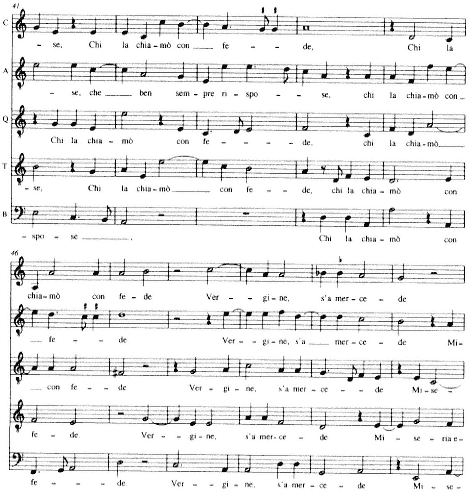
Ex. 63.
Rore, Vergine bella, che di sol vestita (Petrarch, no. 366, stanza 1),
mm. 41-51; Terzo libro a 5 (Venice, 1552), p. 1.
the whole musico-rhetorical context in which each invocation lies. In the passage excerpted in Ex. 63 from stanza 1, the second invocation of v. 9, "Vergine, s'a mercede," gains its presence in relation to the rhymed mate that precedes it (always a source of rhythmic elision), "Chi la chiamò con fede" (v. 8). In Rore's presentation v. 8 is all motion and clarity — the ubiquitous octave leaps, recurrent moves toward cadence, and consistently metric patterning of the declamation. By contrast, the "Vergine" of v. 9 is invoked in a series of plain calls fixed within a static space. Their entrances coincide with the end of the brief circle-of-fifths progression, A-D-G-C, that begins with the cadence of v. 8 (mm. 46-47) and closes in the pile-up of "Vergine" cries at m. 48. Rather than drawing the whole of v. 9's plea into the continuing circular motion, Rore truncates the circle, using its major harmonies to

Ex. 64.
Rore, Vergine santa, d'ogni gratia piena (Petrarch, no. 366, stanza 4),
cantus, mm. 1-5; Terzo libro a 5 (Venice, 1552), p. 4.
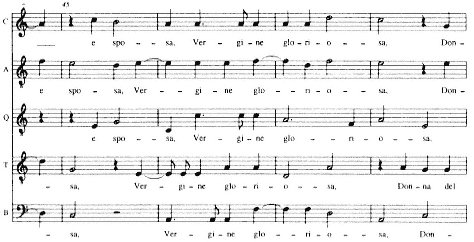
Ex. 65.
Rore, Vergine santa, d'ogni gratia piena (Petrarch, no. 366, stanza 4),
mm. 45-48; Terzo libro a 5 (Venice, 1552), p. 4.
adumbrate and irradiate the Virgin's name. Thus in the cadential m. 47 the invocation is highlighted even as it emerges from the shadowed inner voices whose cadence it shares. In all of this, Rore fuses the demands of a viscous Willaertian polyphony with a newer urge to articulate the separate parts.
Stanza one represents the Virgin in one of her conventional guises as the embodiment of noble simplicity. As set in stanza four, where a lovely "Vergine santa" floats through a minor sixth in the cantus to open the stanza, delicate and untethered in its Phrygian otherworldliness, the invocation calls up more ethereal images (Ex. 64). Here the polyphony too is elusively vague, with uneven entries and whimsical curves. But at v. 9 Rore made the second invocation, "Vergine gloriosa," into a choral acclamation that counterbalances the first (Ex. 65). In the brief space of a semibreve each of the voices is crowded into a thick homophony, with the echoing o' s of "gloriosa" resounding in communal exaltation against the cantus's top-of-the-register dd.
Junctures like these are Rore's rhetorical bread and butter. He handled them in sharper, more striking ways beginning at the sixth stanza (and they were to become far more dramatic still in stanza seven). A passage that occurs at the beginning of the
sirima, is especially revealing since its invocation takes place — most unusually, and problematically, for a musical setting — within a continuous grammatical process.
Ma pur in te l'anima mia si fida, But still my soul relies on you —
Peccatrice, io no 'l nego, A sinful one, I do not deny,
Vergine, ma ti prego Virgin — but I beg you
Ch'el tuo nemico del mio mal non rida. That your enemy not laugh at my harm. 10
Rore's challenge was to project both the invocation and the continuities of rhetorical detail in which it is embedded. To meet it his setting extracts the full measure of rhetorical contrast from the passage with no fewer than four distinct declamatory styles of polyphony (Ex. 66). It may be useful to review them in turn. First, both the end of the piedi and the end of v. 7 are tied off with cadences that enclose the syncopated cross rhythms adopted for the conditional thought at the beginning of the sirima. Two different vocal groupings — cantus, altus, and tenor imitating quintus and bassus — trade a buoyant melody between them as expressive foil for the quasi-parenthetical "Peccatrice, io no 'l nego, / Vergine" that follows. With these words the madrigal opens into a second declamatory style, a series of near-homorhythmic blocks that carry the text along in speech rhythms — an upper-voice trio on "Peccatrice" dovetailing the lower-voice duet "io no 'l nego, Vergine," with cadenze semplici serving as caesurae at mm. 41 and 43. The invocation thus keeps its proper grammatical place, but the full pause that punctuates it supplies retrospectively the sort of structural definition that Rore's rhetorical conception requires. A fuller complement of low voices extends equally speechlike rhythms to the prayer "ma ti prego,"[6] and as it echoes in the lone cantus, a third kind of declamation resonates beneath. This is the sort of spare recitation in overlapping counterpoint common to Willaert's works — and increasingly rare in Rore's. Why "tuo nemico" (your enemy) should elicit such semantic neutrality can only be answered by the need to clear expressive space for the avant-garde flourishes Rore next fashioned for "rida." They count as the fourth distinct textural-declamatory entity to appear in the few bars that compress vv. 7-10. A frenetic kind of mid-cinquecento ars subtilior, these flourishes reduce the rhythmic pulse from the half-note value (minim) to the quarter-note (semiminim), bizarrely and radically dividing the semiminims from the moment the quintus executes a straight suspension cadence in m. 48.
The excerpt shown in Ex. 66 raises several issues that will be central to my consideration of stanza seven. The passage is the first in the cycle in which various voices omit to present the entire poem, as Willaert's madrigals had invariably done. Rore's willingness not to make each part bear the full text marks a critical shift in his thinking about how words and music were to be consolidated. Its implications for the singers' encounter with the poem are profound. And it carries far-reaching
[6] Such speech rhythms reappear in stanza seven (as noted below) and stanza ten, mm. 26-33.
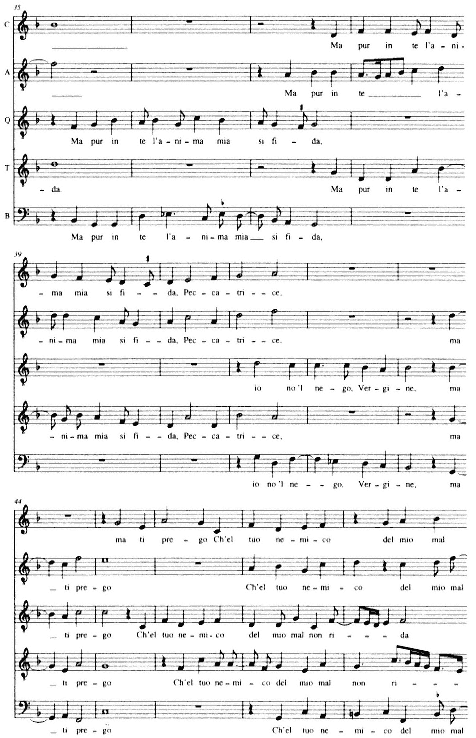
Ex. 66.
Rore, Vergine chiara e stabil'in eterno (Petrarch, no. 366, stanza 6),
mm. 35-53; Terzo libro a 5 (Venice, 1552), p. 6.
(continued on next page)
(continued from previous page)
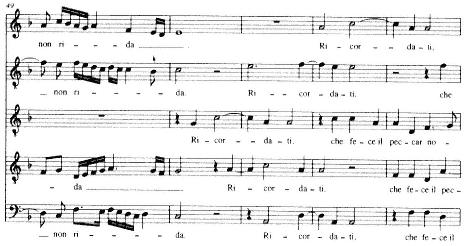
Ex. 66
(continued)
ramifications for texture, ones that are more familiar from the late madrigals of Marenzio, Wert, and Monteverdi.
Once the lyric text was scattered through several parts whose aggregate is needed to enable an integral reading, the linear and individual representation of the poetry by separate voices was sacrificed in favor of the composite, corporate one of the "score." Rather than directing the poetic experience inward toward the sense and intellect of each singer and the communal experience each of them shares, this new approach implies an audience of listeners outside, who are necessary now to construct the poem in its totality. The new approach thus implies projection outward too, with an attendant shift in the statuses of singers (now extroverted performers) and auditors (now passive appreciators). Potentially, at least, the two were more sharply separated than ever before, with professional church singers and female vocalists made indispensable in the parlor room and the relations to them of amateurs dramatically altered.[7]
A crucial corollary of these shifts and ruptures is that if madrigals were now to be sung for auditors, real or implied, they needed to be diverting to hear. A reading projected out of a performative frame, as opposed to a silent or communal one, wants a showier veneer, and those performing it are in turn the showmen and -women rather than mutual participants in an inner experience. This situation ushers in another change hinted at in the passage I quoted from stanza six — a more virtuosic persona. The florid writing on "rida" is harder to sing, harder to count, and harder to coordinate than most anything in earlier madrigals. Its closest kin are
[7] James Haar makes a related point about the new staginess of late-sixteenth-century madrigals at the conclusion of his Essays on Italian Poetry and Music in the Renaissance, 1350-1600 (Berkeley and Los Angeles, 1986), esp. p. 147.
some of the madrigals in the black-note anthologies published by Gardane, to which Rore's first book is obliquely related.[8] With poetic coherence dependent on a dynamic yet well-coordinated performing body, fast shifts of tempo, texture, and vocal style become part of the rhetorical hardware. The whole surface turns more mercurial, more temperamental: Rore's Vergine, though usually serene, at times seems to foreshadow the quixotic stylization of late-sixteenth-century Ferrarese madrigals.
All of these factors come together in Rore's rendering of stanza seven. The single group of words omitted in the texting of stanza six is a mere foretaste of more rampant textual omissions here. In all, four verses receive partial texting, as shown in italics below: v. 1 is given in a homophonic exordium, but only by cantus, altus, and quintus; v. 5 is omitted by the altus; the first part of v. 7 by the cantus and tenor; and v. 12 by the quintus and bassus. (As discussed below, v. 11 also omits its latter part from the repetition made by cantus and altus.) Consequently, the whole poem is delivered with more than usual dispatch.
Vergine, quante lagrim'ho già sparte, Virgin, how many tears have I already scattered,
Quante lusinghe e quanti pregh'indarno, How many pleadings and how many prayers in vain,
Pur per mia pena e per mio grave danno! Only to my pain and my heavy loss!
Da poi ch'io nacqu'in su la riva d'Arno, Since I was born on the bank of the Arno,
Cercand'hor quest'et hor quell'altra parte, Searching in this, now that other direction,
Non è stata mia vit'altro ch'affanno. My life has been nothing but troubles. 6
Mortal bellezza, atti e parole m'hanno Mortal beauty, acts, and words have
Tutt'ingombrata l'alma. Burdened all my soul.
Vergine sacr'et alma, Holy and life-giving Virgin,
Non tardar, ch'io son fors'all'ultim'anno; Do not delay, for I am perhaps in my last year; 10
I dì miei più correnti che saetta, My days, more swift than an arrow
Fra miserie e peccati, Amid wretchedness and sin,
Son se n'andati e sol morte n'aspetta. Have gone away and only Death awaits me. 13
Rore's setting of stanza seven evinces an extraordinary turn in his compositional thinking. His freer disposition of text is linked to a more outspoken rhetoric and a new polyphonic architecture that this rhetoric commanded. The rhythmic and textural diversity and strenuous changes of declamatory tempo with which Rore handled the passage I focused on from stanza six now pervade the entire setting (see Ex. 67). The stanza moves regularly into patter declamation ("in su la riva d'Arno," "atti e parole," "più correnti che saetta," "Son se n'andati" — mm. 36-38, 51-54, 57-58), much of it arrayed in duets or trios with an out-and-out homorhythm of the sort Willaert avoided almost completely in the Musica nova. In place of Willaertian
[8] For a mod. ed. of them see Don Harrán, ed., The Anthologies of Black-Note Madrigals, Corpus mensurabilis musicae, no. 73, AIM, 5 vols. (Neuhausen-Stuttgart, 1978), and on Rore's black-note madrigals idem, "Rore and the Madrigale Cromatico," Music Review 34 (1973): 66-81.
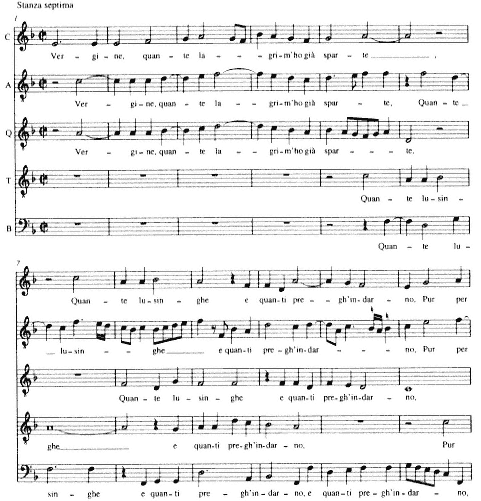
Ex. 67.
Rore, Vergine, quante lagrim'ho già sparte (Petrarch, no. 366, stanza 7),
incl.; Terzo libro a 5 (Venice, 1552), p. 7.
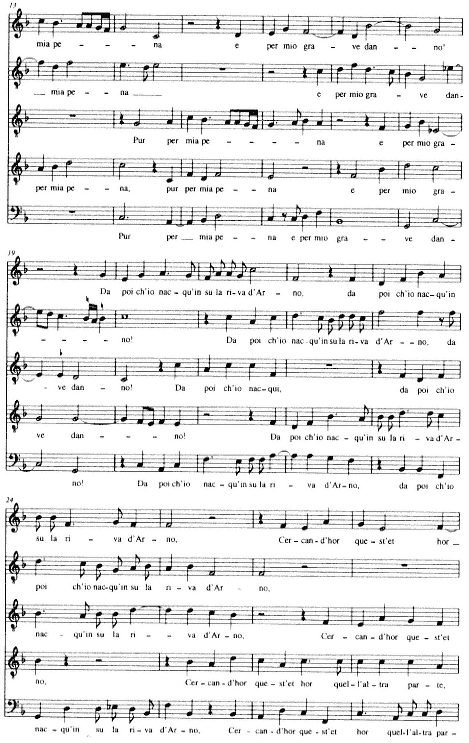
Ex. 67
(continued)
(continued on next page)
(continued from previous page)
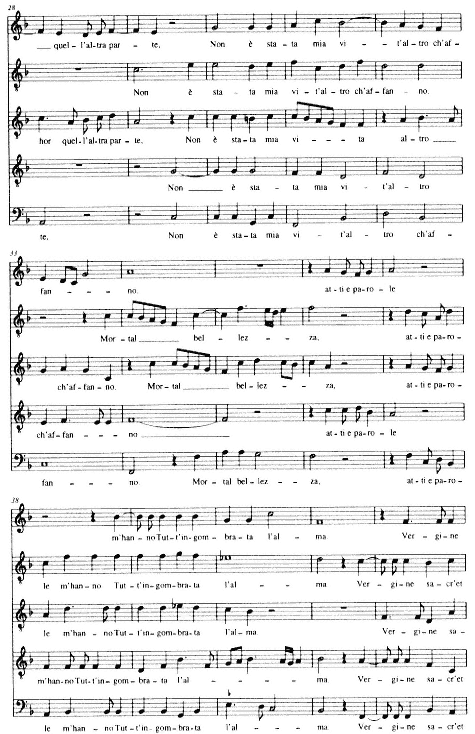
Ex. 67
(continued)
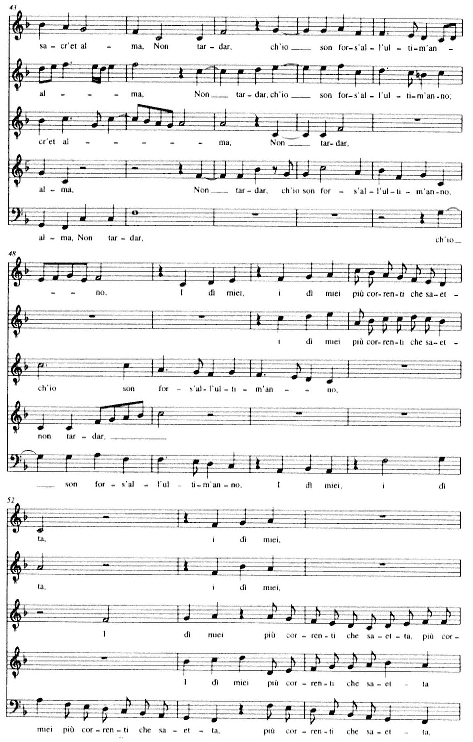
Ex. 67
(continued)
(continued on next page)
(continued from previous page)
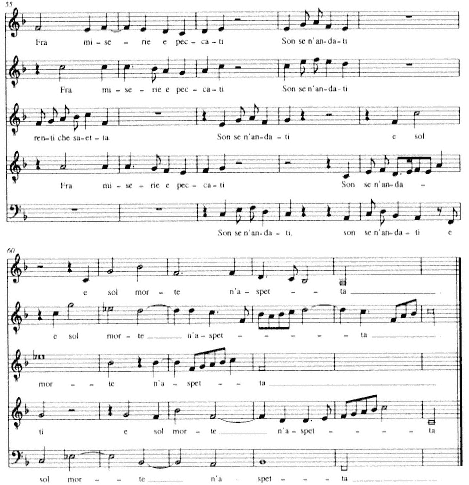
Ex. 67
(continued)
expansion this technique substitutes brevity and concision. (Not by coincidence, stanza seven lasts only 65 breves, five fewer than the next shortest stanza).[9]
The combined effect of these novelties is most pronounced in Rore's setting of the rhetorical point of vv. 11-13 (mm. 49 to the end), a proto-Monteverdian passage without precedent in his earlier canon and one to which we will shortly turn. Up to that point his articulative techniques are in part, at least, still conventional. The first nine to ten verses make a number of traditional suspension cadences, despite some patter rhythms and homophonic textures: a perfect cadence at m. 12 ending v. 2 (c/C, altus and quintus), another at m. 20 ending v. 3 (c/C, altus and quintus), an evaded cadence at m. 34 ending the piedi of v. 6 (aa/F, cantus and tenor), a perfect
[9] Further, the average length of stanzas seven, eight, nine, and ten is six breves less than that of the first six — just over 71 breves as opposed to just over 77.
cadence at m. 36 setting off the "Mortal bellezza" of v. 7 (f/F, altus and bassus), and perfect cadences at mm. 41 and 44 preceding and closing the invocation of v. 9 (b-flat/B-flat, tenor and bassus; f/f, cantus and altus). In mm. 13-16 Rore also made expressive use of two unusual suspension cadences on "pena" — close to what Zarlino would later call cadenze stravaganti. Their resolutions in parallel fifths (between cantus and tenor, mm. 13-14, then quintus and bassus, mm. 15-16) are indeed irregular, yet their contrapuntal techniques remain canonical.
Not all the contrapuntal articulation in the first nine verses is even as straightforward as these examples. With text now omissible from various voices, textures can easily be reduced to two parts or otherwise dissolved for expressive ends. Something approaching what Anthony Newcomb has dubbed the "evaporated cadence" marks off v. 5 (mm. 28-29):[10] the quintus drops to cadence followed a minim later by a suspension-staggered cantus, while the altus that would normally be part of this upper-voice group is denied the verse altogether. Nonetheless the syntactic principles still in force here do not admit a full caesura between vv. 5 and 6. Thus the altus returns with v. 6 at the start of m. 29, overlapping the seam just as the surrounding voices come to rest.
More often than not, however — and this crucial point holds throughout the cycle — suspension cadences, when they do occur, are far more lucid than the ones in the Musica nova. Rore's proclivity toward strong articulation is an enabling factor in the new musical rhetoric that emerges in these later Vergine stanzas. Many of the cadences are perfect, often with the same text ending in both voices, and a good number involve three, four, or all five voices.[11] Even in passages of patter-style duets and trios, Rore fashioned legitimate contrapuntal cadences in a way that brings the chattering homorhythm simultaneously into harmonic and rhetorical focus. The undiminished articulations to aa/a at m. 37 and a/A at m. 38 on "atti e parole," for example, meet quite unproblematically Zarlino's guidelines for "simple" cadences.
By comparison, the cadential constructs of traditional counterpoint fall away almost entirely after the invocation of v. 9, replaced by new modes of articulation — speech rhythms, fast-shifting choral groups, and flashes of textual-motivic fragments — much of it moving by parallel thirds and six-three chords. The setting opens onto this new terrain with two sharply drawn motivic gestures, the pithy head motive on the nominative "I dì miei" offset by a run of semiminims for the comparative "più correnti che saetta." From this lopsided opposition (three syllables vs. eight) Rore drew forth contrasting sounds and rhythms that help distill the semantic essence of each, working them, in the manner of fugal subject and countersubject, into a dynamic multiple counterpoint. The head motives, stolidly equalized in conjunct minim ascents (e.g., cantus: c-d-e, rest, f-g-aa, mm. 49-50), are neutralized metrically by their open-ended linearity and avoidance of downbeat.
[10] See The Madrigal at Ferrara, 1579-1597, 2 vols. (Princeton, 1980), 1: 120 n. 16.
[11] Cf. the discussion of Per mezz'i boschi, Chap. 8 above, n. 20 and Table 7.
This equalization increases the sonorous parity between vowels of the first phrase ("i," "i," and "iei") well beyond the level of spoken prosody. The rushing tail motive, usually anchored to consecutive downbeats equal in status on an implied metric grid (e.g., mm. 51-52), brings out only vowels regarded as piacevole by contemporaneous literati — the two "e" sounds on "correnti" and "saetta." From mm. 49-52 the cantus traces an arc from c to cc and back, with two statements of the head motive, one of the tail. Motivically, the two motives stand in a bipolar relationship: with the tail inverting the melodic direction and doubling the declamatory speed, they form antitheses — of up vs. down, ametric to metric, "i"/"iei" to "e," and slow vs. fast.
The larger goal of this motivic polarization is a flexible multiple counterpoint that embodies text as a virtual physical presence. No sooner is the consequent broached in m. 51 than the head motive enters beneath it in the role of bass line (mm. 51-52). The two form a pseudo-villanella texture as the upper voices turn quickly into parallel thirds ("che saetta") against the slower bass line. This is the same sort of villanella-like texture that proliferates in the pastoral madrigals of Andrea Gabrieli and Luca Marenzio and the later assimilations of their styles by Wert, Monteverdi, and others.[12]
In subsequent measures these same motives continue searching out new and varied scorings, transposing the consequent back to the lower register and arraying the parallel thirds anew. Rore's textual omissions allow him some delightfully unforeseen turns. As the cantus-altus duo falls unexpectedly mute after m. 53, the way is cleared for their languorous trio with the tenor of mm. 55-57 — a two-breve interlude on the miseries and sins of v. 12. This passage transforms the earlier parallel-third motion by expanding it into a doleful plaint of fauxbourdon.[13] At the next rescoring it is bassus and quintus, silent since v. 11, who come (for the first time) to the fore. Cadencing as part of a C-major triad with "Son se n'andati" (m. 58),[14] they restore the previous contrapuntal climate — root-position harmony along with imitative duets, chipper canzonetta homorhythms, and parallel thirds.
One event thus vanishes as quickly as the next. The final poetic turn to the poet's anticipation of death, "e sol morte n'aspetta," brings a last shift of texture, pace, and tonality as evanescent as any. It flips the tonal orbit suddenly backward to the flat side and introduces an unsettling string of intervals spanning minor sevenths (quin-
[12] According to Gary Tomlinson, Monteverdi borrowed the device from Marenzio's Non vidi mai dopo notturno pioggia (see Marenzio, Madrigali a quattro voci of 1585), to use in his Non si levava ancor l'alba novella, printed in Monteverdi's Secondo libro a 5 of 1590; see Monteverdi and the End of the Renaissance (Berkeley and Los Angeles, 1987), pp. 42-44.
[13] The technique was picked up by Wert. For an early instance of it see Wert's setting of Petrarch's Voi ch'ascoltate in rime sparse 'l suono, mm. 24-29, from his Madrigali del fiore, libro secondo (Venice, 1561); mod. ed. in Collected Works, ed. Carol MacClintock with Melvin Bernstein, Corpus mensurabilis musicae, no. 24, AIM ([Rome], 1962) 2:5. Verdelot sometimes wrote similar counterpoint, but melismatically.
[14] The cadence to e in the cantus of m. 57 is strange in the context of the apparent mode 6 — a clausula peregrina, as Meier calls it (The Modes, p. 252). But must we view it in such modal terms? The effect is that of a half-cadence, an actual dominant in this case. One senses a moving away from modal principles in the setting of vv. 11-13.
tus, bassus, cantus) and ninths (cantus, mm. 61-65) in a move of unprecedented dramatic force before dissipating in the ethereal cadences of the final measures.
These transformations of Venetian style raise profound questions about how and why Rore now reads text so differently from the way he had before. His writing here rejects the staid introspection, balance, and temperance that Musica nova -styled madrigals made all-important. In their place it proposes something almost gleefully hedonistic. The flood of motives is so thick and fast that few affective-semantic entities stay in place long enough to sink in. The vivid contrasts that unfold so rapidly in parts of the Vergine setting leave the auditor no chance — indeed no time — to enter a meditative state. Radically disjunct, they are often abandoned before the listener can ever begin to legitimize them.
Rore's now extreme iconic interpretations are inevitably fragmenting even in semantic terms. They destabilize lyrics by focusing on the single word and on isolated word groups. The startling verbal disembodiments that result are not just grammatical, hence formal, ones. In Rore's rendition, phrases like "più correnti che saetta" and "son se n'andati" could have been found in the most secular contexts, depicting the wiles of Cupid or the woes of a forsaken lover, rather than in a confessional prayer on life's sins and a presage of death.[15] Even the last and most explicit iteration of this confession, "e sol Morte n'aspetta," undercuts the anticipation of death to which Petrarch's words point by winding them voice to voice in a sumptuous stream of melismas.
Here Rore flirts with unabashed showmanship and flagrant sensuality.[16] His novelties do not, after all, simply "raise" music's level to meet abstract ideals of rhetorical sophistication — something we might impute to more conventional Willaertian madrigals — but confront the most performative aspect of Petrarch's poetics, his lyric bravura, with a new contrapuntal prowess. Neither Rore nor Willaert, nor anyone attempting to hear rhetoric in so close a way as they, would have been deaf to Petrarch's tremendous formal virtuosity, its signifying power, and the contradictions it poses with Petrarchan thematics. As Robert M. Durling has put it, the "self-conscious technical mastery" that Petrarch flaunts and worries time and again is "integral to his expressiveness."[17] It is this linguistic virtuosity, this formal gamesmanship in Petrarch's lyric achievement, that Rore's new readings isolate and elevate.
Indeed his is arguably a reading admitted within this seemingly most pious of canzoni, the Vergine poem itself. Petrarch's wily poetics, his nearly subversive formal
[15] For other words and phrases taken out of context see stanza three, "in allegrezza torni" (mm. 51-55), a reference to the Virgin's effect on the tears of Eve, and stanza four, "il Sol che rasserena" (mm. 27-30), to the brightening power of the sun.
[16] Similar melismas occur in stanza two, "chiara lampa" (mm. 17ff.) and "fortuna" (mm. 32ff.), and in stanza eight, "Tu ved'il tutto" (mm. 52ff.).
[17] Petrarch's Lyric Poems: The "Rime sparse" and Other Lyrics (Cambridge, Mass., 1976), p. 12.
manipulations, at times call the fundamental seriousness — or at least sacredness — of the whole poem into question, and with a measure of metaliterary distance that permeates the entire Canzoniere. An almost reckless instance of this comes in the middle of stanza eight, as Petrarch problematizes his always ambiguous address to the Virgin.
Hor tu, Donna del ciel, tu nostra Dea, Now you, Lady of Heaven, you our Goddess
Se dir lic'e conviensi, (If it is permitted and fitting to say it),
Vergine d'alti sensi, Virgin of deep wisdom:
Tu ved'il tutto, e quel che non potea You see all, and what another could not 10
Far altri è null'a la tua gran virtute. Do is nothing to your great power:
Pon fin al mio dolore, Put an end to my sorrow,
Ch'a te honore et a me fia salute. Which to you would be honor and to me salvation.
Petrarch's ambivalent "Vergine" is never entirely distinct in his Canzoniere from the virginal Laura (nor Laura from Her). Here She is a pagan goddess, "Donna del ciel, tu nostra Dea." Petrarch's obsequious bowing and scraping in v. 8 ("se dir lic'e conviensi") only draws attention to the audacity of his address and the forever unresolved and partial status of his faith, so necessary to sustaining his poetic design.[18]
Rore picks up Petrarch's cue in mm. 47-63 (see Ex. 68). After a full pause marks off v. 8, She becomes the "Vergine d'alti sensi," as lightly told in a choral exchange of lower and upper voices. She sees all ("Tu ved'il tutto"), they continue, jauntily weaving fast-dotted melismas between them until their dissolution in m. 54.[19] Thereafter a shift to triple meter, the first of two such in the last few stanzas of the cycle,[20] leads to a cheerful course of florid parallel tenths (cantus and bassus, mm. 60-61) in celebration of her "gran virtute."[21]
This passage seems unabashedly flippant but in a way that becomes typical of the last five stanzas.[22] Rore's reading moves decidedly away from the patriarchal and Ciceronian orientation of Willaert's settings.[23] To be sure, it extends directions
[18] Note too the presumptuous conclusion, where the consolatory function that she plays toward him becomes a source of her honor.
[19] The same sorts of dotted melismas can be seen in stanza five, altus, m. 41, on "gioconda."
[20] The other occurs in stanza ten, mm. 62-63.
[21] Simultaneous melismas of this sort do not appear in the Musica nova. Other examples in the Vergine cycle may be found in stanza two, mm. 60-61 (with parallel sixths between the upper voices), stanza four, m. 71 (parallel thirds between quintus and tenor), and stanza ten, mm. 65-66 (parallel sixths between cantus and tenor).
[22] Earlier stanzas toy with a similarly brazen rhetoric, though to a lesser extent. In stanza one, mm. 59-66, for instance, as Petrarch beseeches the Virgin to turn to his prayer and aid in his war ("al mio prego t'inchina;/Soccorri a la mia guerra," vv. 11b-12), Rore launches the first of his dotted-note melismas and syncopated minim/semiminim cross rhythms. Once the poet declares himself but earth beside her heavenly reign ("bench'io sia terra et tu del ciel Regina," v. 13, with its internal rhyme to "guerra"), his fawnings begin to look like a thin excuse for bravura paradox. For this Rore makes a dip into his lowest tessitura and drollest affective regions. (Another example of the cross rhythms found here crops up in stanza six, "Di questo tempestoso mare stella," mm. 11-15.)
[23] My thinking here has been influenced by William J. Kennedy's interpretations of Petrarchan commentaries like Bernardino Daniello's Sonetti, canzoni, e triomphi di Messer Francesco Petrarca con la spositione (1541; Venice, 1549) that emerged from the Venetian milieu during the third to fifth decades. Kennedy's forthcoming book on sixteenth-century Petrarchan commentaries promises fascinating new insights into relationships between civic and personal identities and modes of reading.
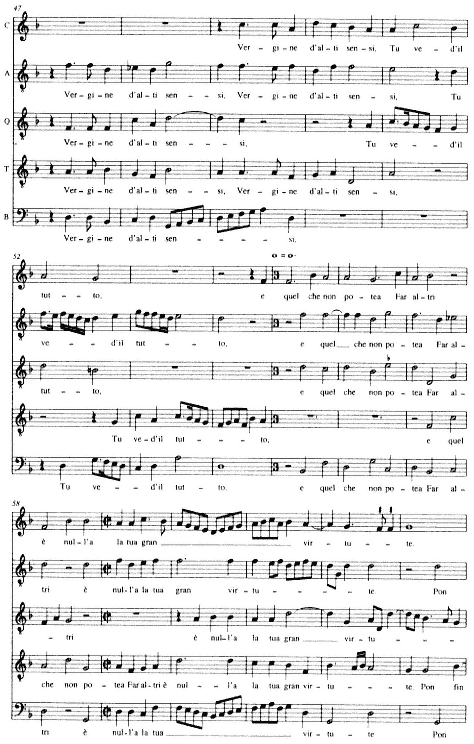
Ex. 68.
Rore, Vergine, tal è terra e post'ha in doglia (Petrarch, no. 366, stanza 8),
mm. 47-63; Terzo libro a 5 (Venice, 1552), p. 8.
anticipated in his first two books of madrigals, which ruffled Willaert's smooth Ciceronian surfaces by periodically disrupting the placid and continuous polyphonic flow. Already in a Dantean madrigal like Strane ruppi Rore maximized gestures of destabilizing discontinuity: consecutive leaps, fast, vaulting melismas, constant voice crossings, strings of inverted triads, textural evaporations, suspended dissonances, and tone clusters generated out of anticipated notes of resolution.[24] Where Willaert mainly stuck to verbal projection through linguistic structure — syntax — Rore balanced syntactic with semantic considerations. It is no surprise that Rore's early books continued to be reprinted into the 1590s.[25]
All of this we might view as underpinning his later seconda pratica style, if not actually broaching its harmonic experiments. To see in the madrigals of Rore's Books 1-3 a monolithic repertory, therefore, all falling under the rubric "Venetian," is to miss the new stirrings in Book 3 and even Rore's earlier books. It was the Vergine cycle that explicitly enunciated rhythmic and textural procedures that were essential to Rore's late compositional techniques. Far more than the early sonnet settings I have discussed, the Vergine forms a link between the classic Venetian style of the early forties and the late madrigalistic idioms of the north Italian courts, Ferrara and Mantua. It looks at once backward over the monumental style of the 1540s and forward to various quixotic strategies of the late 1550s and beyond, strategies at once iconic and iconoclastic.
I am tempted to propose, finally, that Rore's Vergine theatricalized text in a way that post-Ciceronian poetics encouraged. Aristotelian notions of imitation that were just then beginning to supplant Ciceronian ones bedazzled practitioners of mimetic arts with their vivid iconic promise and possibilities for imitating directly natural human speech and action. Rore's demonstrative imitations of textual events resonate in sympathy with this representational mimetic model. In making them he put at risk Venice's Ciceronian supertrope, its trope of tropes, decorum, pushing it from its dominant space at the center of discursive practice to a marginal position outside.
[24] See Chap. 8 above, pp. 285-93, for a discussion of the madrigal.
[25] On Rore's legacy see Meier's foreword to the Opera omnia 2:i-ii.